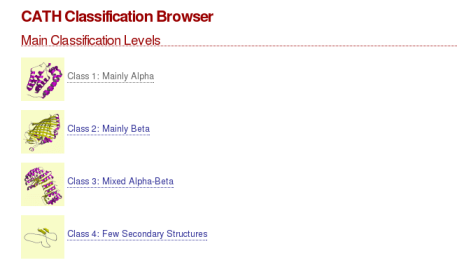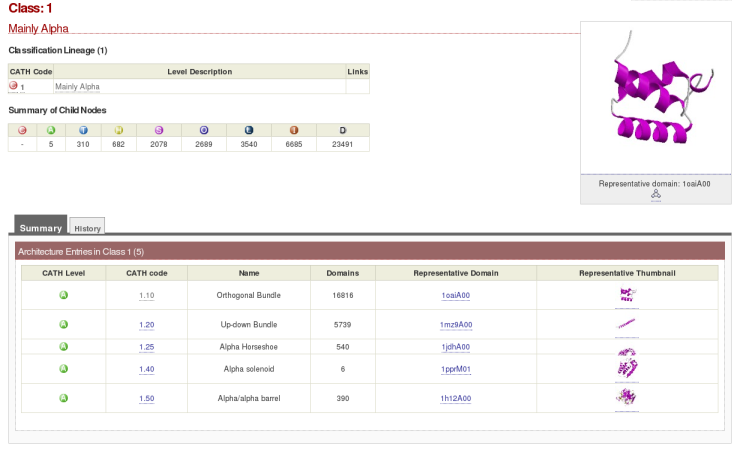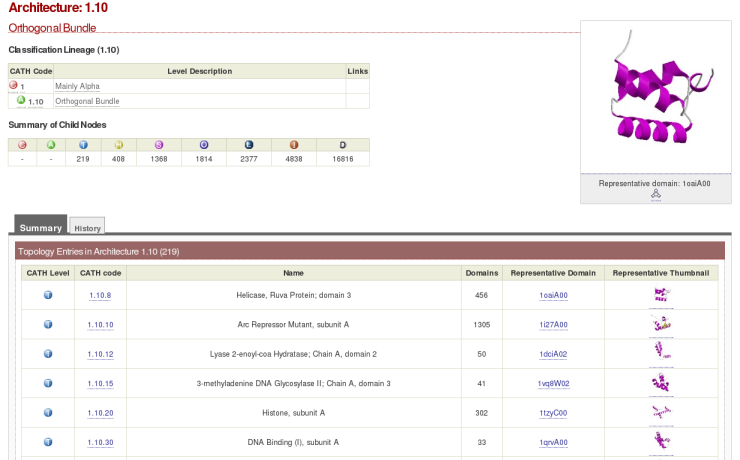How to Browse the Four Major Clusters in the CATH Hierarchy
It is possible to browse the four major levels of the CATH hierarchy by clicking on 'Browse CATH from the top of the hierarchy,' which is located on the CATH start page under the heading 'Links for Researchers.' This will take you to a page that looks like this:
This page can also be accessed through the 'Search CATH by ID/Sequence/text' link, clicking the 'Browse' button following 'Start Browsing at the top of the CATH hierarchy.'
From this page it is possible to explore the four major levels of CATH (Class, Architecture, Topology and Homology) by clicking on any of the class names. Doing so will take you to the information page for that particular Class, for example, for class 1:
Near the top of the page is given a 'Summary of Child Nodes' table showing how many Architectures, Topologies, and Homology families this Class has been divided into, and also how many Sequence families there are at each different level (SOLID). It is not possible, however, to view how many Topologies each Architecture has been divided into, nor is it possible to view how many Homology families each Topology has been divided into, and so on. To do so you have to browse further through the CATH hierarchy.
Under the 'Summary' tab is shown a list of all of the Architecture entries in Class 1. This table gives the following information:
- That Class 1 has been divided into five different Architectures
- The CATH code and the name of each of the Architectures
- How many domains belong to each of the Architecture groups in the chosen Class
- Each Architecture has its own domain representative. The representative domain gives a visual explanation of the Architecture's name. It is possible to enter a representative domain's information page by clicking on its domain ID, or to search further through the CATH hierarchy by clicking on any of the Architectures' CATH codes.
For example, clicking on the CATH code '1.10' will bring you to the following page:
The 'Orthogonal Bundle' Architecture, 1.10, actually contains 219 Topologies in CATH version 3.2.0, but only the first six are shown in this image. Once again the two summary tables can be seen but the information presented has changed to describe:
- How many Topologies and Homology families this Architecture has been divided into
- How many Sequence families there are at each different level (SOLID)
- How many domains belong to each of the Topology groups in the chosen Architecture
- The CATH code and the name for each of the Topologies
- Each Topology has its own domain representative. The representative domain gives you a visual explanation of each of the Topology names. It is possible to enter the domain's information page by clicking on the domain's ID
Links to Other Tutorial Pages
| Page | Description |
|---|---|
| pdb_code_domain_id_search | How To Find a Particular Domain To find a particular domain, use either the CATH domain ID, CATH chain ID or the PDB code as the search term. The search term can be entered into the 'Quick Search' box in the top right-hand corner of any CATH page, or into the 'Search by ID/Keywords' box on the 'Search CATH by ID/sequence/text' page accessible from the CATH homepage. Using the protein '1ucr' as an example, a search should come up with the following: |
| text_search | How To Perform a Text Search It is possible to search the CATH database using any search word. For example, the word may be of functional origin, such as 'chaperone,' or structural, such as 'helix'. The search word can be entered in the 'Quick Search' box in the top right-hand corner of the screen, or into the 'Search by ID/Keywords' box on the 'Search CATH by ID/sequence/text' page accessible from the CATH homepage. The search word 'lysine' will generate a result page that looks like this: |


